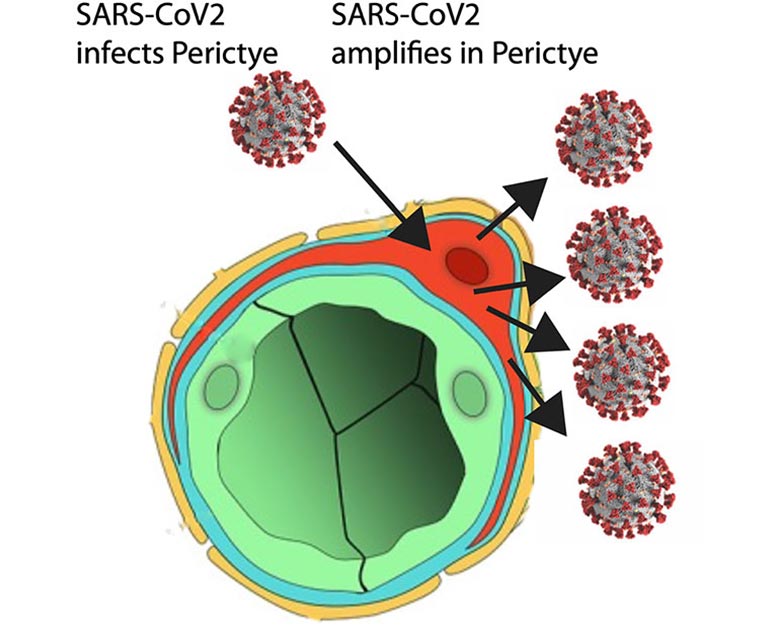3D “Assembloid” Shows How the COVID-19 Virus Infects Brain Cells
0 View
Share this Video
- Publish Date:
- 21 July, 2021
- Category:
- Covid
- Video License
- Standard License
- Imported From:
- Youtube
Tags

Image shows SARS-CoV-2 spreading through blood vessels (green) to infect pericytes (red), which amplify the infection and can spread infection to other cell types in the brain. Credit: UC San Diego Health Sciences
Researchers from the University of California San Diego School of Medicine and Rady Children’s Institute for Genomic Medicine have produced a stem cell model demonstrating a possible entry route of SARS-CoV-2, the virus that causes COVID-19, into the human brain.
The findings are published in the July 9, 2021 online issue of Nature Medicine.
“Clinical and epidemiological observations suggest that the brain may be involved in SARS-CoV-2 infection,” said senior author Joseph Gleeson, MD, Rady Professor of Neuroscience at UC San Diego School of Medicine and director of neuroscience research at Rady Children’s Institute of Genomic Medicine.
“The prospect of brain damage caused by COVID19 has become a primary concern in cases of ‘prolonged COVID’, but human neurons in culture are not susceptible to infection. Previous publications suggest that the cells that make the spinal fluid could become infected with SARS-CoV-2, but other avenues of entry seemed likely.”
Gleeson and colleagues, including both neuroscientists and infectious disease specialists, confirmed that human neural cells are resistant to SARS-CoV-2 infection. However, recent studies hinted that other types of brain cells could serve as a ‘Trojan horse’.
Pericytes are specialized cells that wrap around blood vessels and carry the SARS-CoV2 receptor. The researchers introduced pericytes into three-dimensional neural cell cultures — brain organoids — to create “assembloids,” a more advanced stem cell model of the human body. These assemblies contained many types of brain cells in addition to pericytes and showed robust infection by SARS-CoV-2.
The coronavirus was able to infect the pericytes, which served as localized factories for the production of SARS-CoV-2. This locally produced SARS-CoV-2 could then spread to other cell types, leading to widespread damage. Using this improved model system, they found that the supporting cells known as astrocytes were the main target of this secondary infection.
The results, Gleeson said, indicate that a possible route from SARS-CoV-2 to the brain is through the blood vessels, where SARS-CoV-2 can infect pericytes, and then SARS-CoV-2 can spread to other brain types. cells.
“Alternatively, the infected pericytes can lead to inflammation of the blood vessels, followed by clotting, stroke or bleeding, complications seen in many patients with SARS-CoV-2 who are hospitalized in intensive care units.”
Researchers now plan to focus on developing improved assembloids that contain not only pericytes, but also blood vessels capable of pumping blood to better model the intact human brain. These models, Gleeson said, could provide greater insight into infectious diseases and other human brain diseases.
Reference: “A human three-dimensional neural-perivascular ‘assembloid’ promotes astrocyte development and enables modeling of SARS-CoV-2 neuropathology” by Lu Wang, David Sievert, Alex E. Clark, Sangmoon Lee, Hannah Federman, Benjamin D Gastfriend, Eric V. Shusta, Sean P. Palecek, Aaron F. Carlin, and Joseph G. Gleeson, July 9, 2021, Nature Medicine.
DOI: 10.1038/s41591-021-01443-1
Co-authors include: Lu Wang, David Sievert and Sangmoon Lee, UC San Diego and Rady Children’s Institute for Genomic Medicine; Alex E. Clark and Aaron F. Carlin, UC San Diego; Hannah Federman, UC San Diego, Rady Children’s Institute for Genomic Medicine and Rutgers University; and Benjamin D. Gastfriend, Eric V. Shusta and Sean P. Palecek, University of Wisconsin-Madison.
Funding for this research came in part from the Rady Children’s Hospital Neuroscience Endowment, the Burroughs Wellcome Fund, the Brain & Behavior Research Foundation NARSAD, the National Institutes of Health (grants NS103844, T32GM008349), the National Science Foundation Graduate Research Fellowship Program (1747503 ) the UC San Diego Neuroscience Microscopy Core Facility grant (P30NS047101) and the UC San Diego IGM Core Facility grant (1S10OD026929).










